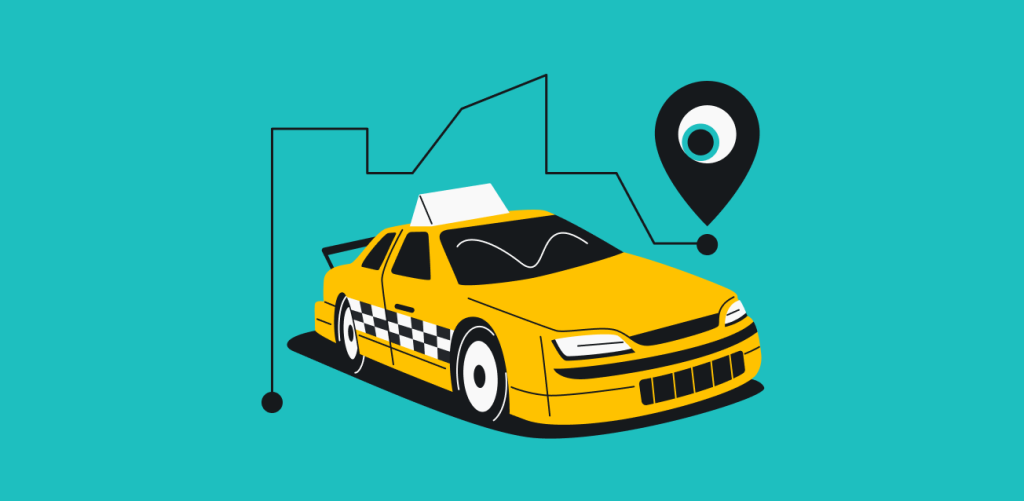
When was the last time you hailed a taxi on the street?
Ride-hailing has become completely digital over the last decade. Taxis are now on apps like Uber, Lyft, Bolt, and they’ve made commuting easy. And it’s not just money we pay for this convenience, but it’s also our data.
Ride-hailing apps collect a lot of information about their users and often share this data with third parties for marketing purposes. That’s why our research team has decided to deep-dive into the world of ride-hailing and see which services are the most data-hungry using our data sensitivity index.
Ride-hailing and the data sensitivity index
We took 30 ride-hailing apps from the Apple Store and compared their data collection practices (note that apps from the Google Play Store may have different privacy settings). The Apple Store collects 32 different types of data that we used to create the data sensitivity index.
The index measures how data-hungry ride-hailing apps are using a simple point system. These points were calculated as follows:
- The app received 1 point for data that’s not linked to a user’s identity (such as app crash data).
- The app received 2 points for data that could be linked to a user’s identity (such as name).
- The app received 3 points for data that could track users across apps and websites (such as user ID).
Here are the full results using the index:
What data ride-hailing apps collect
Our data collection analysis of ride-hailing apps shows that:
- Hailing and taxi apps collect on average 14 data points per user, and almost half of all apps collect more data than the average of all analyzed apps.
- Only 20% of analyzed mobility apps collect less than 10 data points about their users.
- The most data-hungry app (GrabTaxi) collects almost ten times more data than the least data-hungry app (Rapido).
- GrabTaxi collects 27 out of 32 possible data points listed by Apple. However, Rapido delivers the same service as GrabTaxi (bringing its customers from point A to B) using only their user’s name, phone number, and location.
- Both Uber and Lyft collect sensitive user information (sensitive information can include race, ethnicity, sexual orientation, pregnancy, childbirth information, religious, political and philosophical beliefs, trade union membership, genetic information, or biometric data).
Countries that use data-hungry ride-hailing apps the most
Uber and Lyft might be popular, but they’re not universal. The popularity of these apps varies across regions and different countries. That’s why it’s important to distinguish where people are more exposed to data-hungry apps. Here’s a table that ranks the top 10 most data-hungry apps and which countries they’re popular in:
Mobility app | Data sensitivity index | Countries |
|---|---|---|
GrabTaxi | 114 | Macao, Singapore, Indonesia, Vietnam |
Yandex | 81 | Kazakhstan, Uzbekistan, Kyrgyzstan, Russia, Belarus, Moldova, Estonia, Georgia, Armenia |
Uber | 80 | Australia, New Zealand, Japan, United States, Canada, United Kingdom, Ireland, Norway, Finland, Denmark |
Ola | 52.8 | New Zealand, India, Tanzania, Oman |
Lyft | 47 | El Salvador, Puerto Rico, Jamaica, Trinidad and Tobago, United States, Canada, Ireland, Myanmar, Cameroon, Turkey |
Cabify | 45 | Spain |
Blue Bird | 43 | Indonesia |
Easy taxi | 42 | Argentina, Peru, Uruguay |
KakaoTaxi | 40.8 | Korea, Republic of, China, Macao, Venezuela, Philippines, Cambodia, Myanmar, Uganda |
Didi | 38.4 | Australia, Japan, China, Mexico, Chile, Colombia, Ecuador, Costa Rica, Cambodia, Iran |
For the full research material behind this table, feel free to visit here.
The top 3 most data-hungry ride-hailing apps
Out of all the reviewed ride-hailing platforms, GrabTaxi, Yandex Go, and Uber (followed by FREE NOW) stood out as the most data-hungry apps by a large margin. Let’s break the three cases down one by one.
No. 1 GrabTaxi
GrabTaxi is the second-most popular app in South-eastern Asia, particularly in countries like Singapore and Vietnam. The service had 68 million unique users in 2018 and an estimated 122 million in 2019.
GrabTaxi collects 27 out of 32 possible data points listed in the Apple Store. The only types of data it doesn’t collect are health & fitness, sensitive information (race, ethnicity, religion, etc.), and gameplay content. The app also shares some of its collected data like product interaction, name, email, phone number, and user ID with third parties.
No. 2 Yandex Go
Yandex Go is most popular around Central Asia and in countries like Kazakhstan, Kyrgyzstan, and Russia. The app collects data such as purchase and search history, precise and course locations, all users’ contact information and identifiers such as user ID and device ID. Yandex Go also has access to their user’s photos, videos, and audio data.
No. 3 Uber
Uber is the most popular ride-hailing app across most of the world. It disrupted the Taxi market with its entry, and somewhere around 2019 had 110 million monthly users in the United States alone.
Just like Yandex Go, Uber collects a lot of the same data points. But it also includes sensitive information.
The app also has access to its users’ videos, photos, texts and emails.
The top 3 least data-hungry ride-hailing apps
On the other side of the data collection coin, we have apps that barely collect any information. The ride-hailing services least hungry for users’ data are Rapido, Taxi EU, and LeCab.
Rapido
Rapido is an Indian service that only requires data necessary for the app’s functionality – course location, user’s name and phone number.
Taxi EU
Taxi EU is a Taxi service based in Europe. Aside from data that the app requires to function, it collects some analytics data to improve their services like crash, performance, usage, product interaction and similar data.
LeCab
LeCab is a French Taxi app. Aside from app functionality and analytics data, LeCab also requires a physical address, precise location and email address. While such data is considered private information, its collection is justifiable as it’s also needed for the app to function.
How ride-hailing apps turn data into extra revenue
Apps often ask for permissions to access different parts of their user’s device like contacts, microphone, and even camera. This allows them to collect information about their users that they can package and use for extra revenue.

Ride-hailing apps are no different – they collect a lot of user data, and some of them even use it for target ads and marketing products from different companies:
- Curb collects six types of data points, 4.5 times less than GrabTaxi, but still manages to share that data with third-party advertisers.
- 9 out of 30 analyzed apps use their collected data for “Third-Party advertising”:
Ride-hailing app | Data shared with advertisers |
|---|---|
GrabTaxi |
|
FREE NOW |
|
Ola |
|
KakaoTaxi |
|
DiDi-Rider |
|
99 |
|
Beat |
|
Zipcar |
|
Curb |
|
Methodology
We compared data collected by 30 mobility apps based on the 32 types of data that the Apple Store lists. Apps from the Google Play Store might have different privacy settings.
The index was calculated by assigning the value from 1-3 to each data point by how much it could potentially expose the user:
- 1 point: “Data Not Linked to a user” – data that is not linked to a user’s identity (such as app crash data)
- 2 points: “Data Linked to a user” – data that may be linked to a user’s identity (such as name)
- 3 points: “Data Used to Track users” – data that may be used to track users across apps and websites owned by other companies (such as User ID).
Apps were ranked by the index value in descending order. Additional 20% of the sum points were added if the company uses collected data for “Third-Party advertising”. Apps were ranked by the index value in descending order.
An app’s popularity was determined by SimilarWeb “Country Rank” data. The higher the rank, the more popular the mobility service is considered to be in a country. Sub-region app popularity was determined by counting the number of countries in the sub-region where the app ranks TOP1 or TOP2 by SimilarWeb “Country Rank” compared to the rest of the analyzed apps.
For the full research material behind this study, feel free to visit here.
